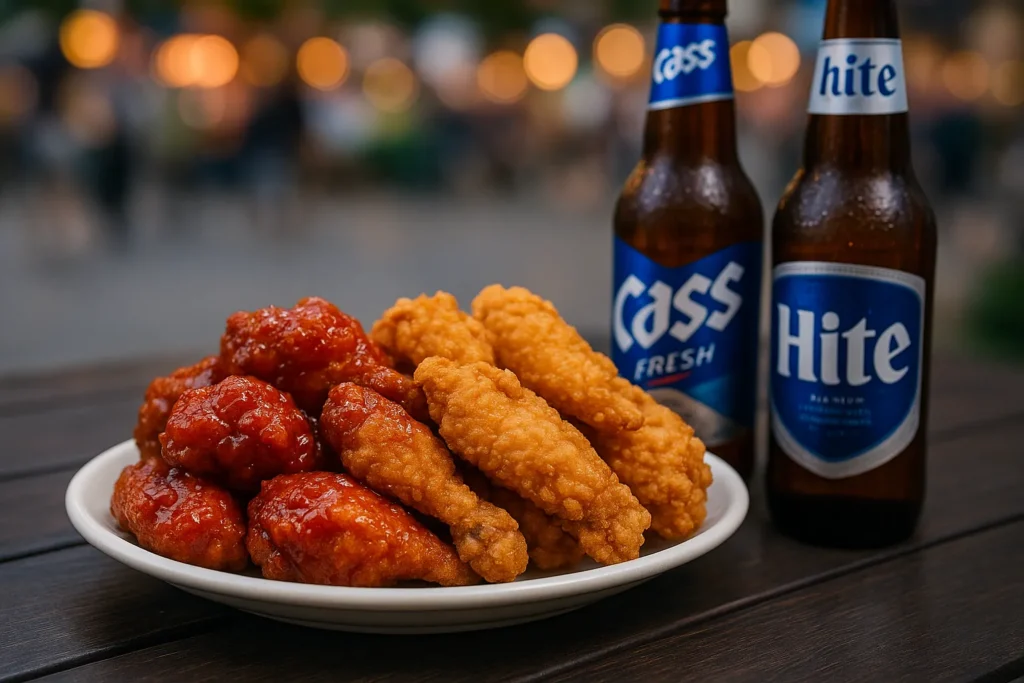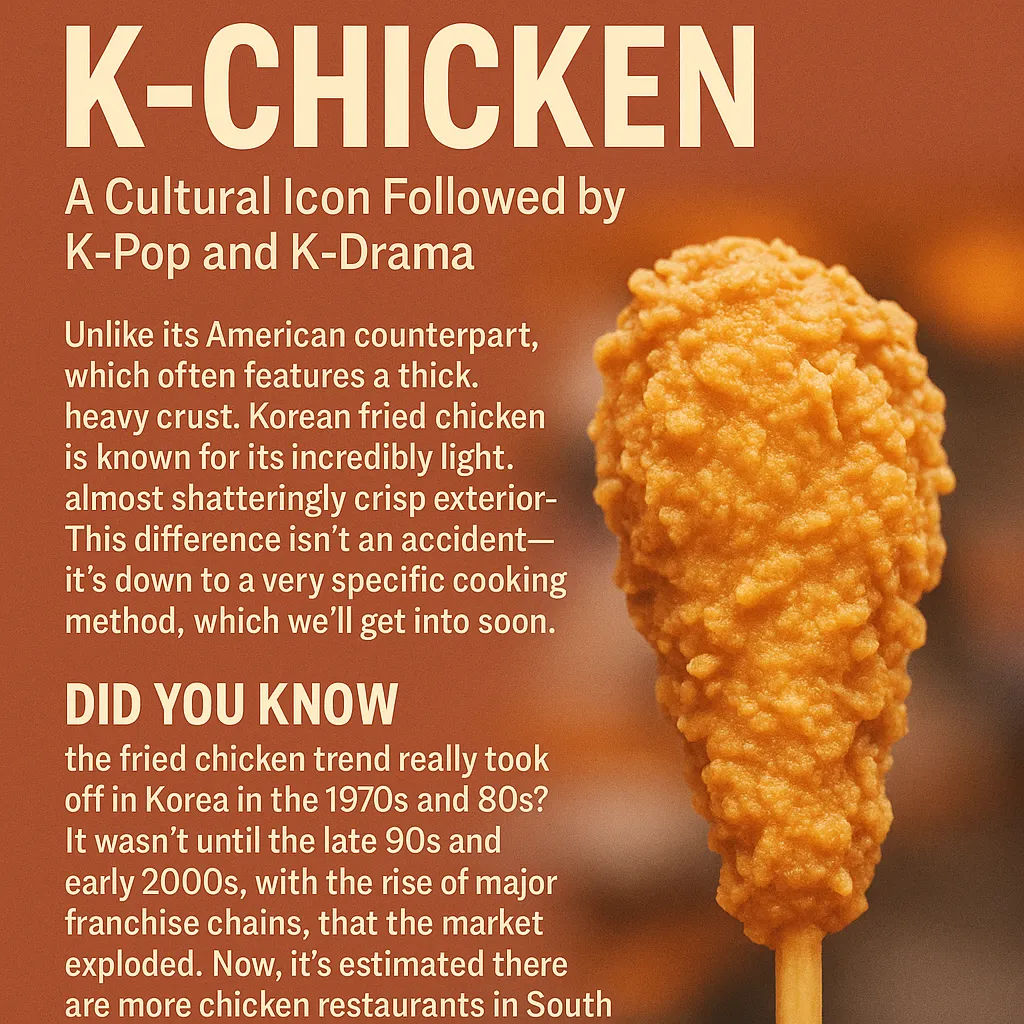I’ll be honest, the first time I had Korean fried chicken—I was completely blown away. I thought I knew fried chicken, but this was something else entirely. That delicate, paper-thin crunch, the perfectly seasoned meat, and the incredible array of sauces… Seriously, Western fried chicken just doesn’t compare to the experience of a fresh batch of K-Chicken. 😊
If you’ve heard the buzz or are planning your first trip to a Korean chicken shop, you’re in the right place! We’re diving deep into the world of K-Chicken, unraveling its unique charm, and giving you the insider tips to enjoy the true ‘Chimaek’ culture. Ready to explore the crunch? Let’s go!

The Global Rise of K-Chicken (Korean Chicken) 🌍
K-Chicken isn’t just a snack; it’s a cultural icon that has followed the K-Pop and K-Drama waves worldwide. Unlike its American counterpart, which often features a thick, heavy crust, Korean fried chicken is known for its incredibly light, almost shatteringly crisp exterior. This difference isn’t an accident—it’s down to a very specific cooking method, which we’ll get into soon.
Did you know the fried chicken trend really took off in Korea in the 1970s and 80s? It wasn’t until the late 90s and early 2000s, with the rise of major franchise chains, that the market exploded. Now, it’s estimated there are more chicken restaurants in South Korea than McDonald’s and Subway combined! That’s just wild, right?
Because K-Chicken often uses a thinner batter and is fried at a higher temperature (often double-fried), it renders out more fat, making the crust less greasy than traditional American fried chicken. Still fried, but definitely less heavy!
Understanding the Magic: Key Differences from Western Fried Chicken ✨
The secret to the legendary crunch lies in two main aspects: the batter composition and the double-frying process. Traditional Korean recipes often skip egg and use starches like potato starch or corn starch alongside flour, resulting in a lighter crust. The double-fry technique is crucial:
| Feature | Korean Fried Chicken (KFC) | Western Fried Chicken |
|---|---|---|
| Crust Texture | Thin, glassy, and exceptionally crisp. | Thick, flaky, and heavier. |
| Frying Method | Almost always double-fried to remove fat. | Typically single-fried. |
| Sauce Application | Brushed or tossed after frying, creating a glaze. | Often served with sauce on the side or a dry coating. |
Your Essential K-Chicken Flavor Guide 🍗
When you open the menu, you’ll see a dazzling array of options. It can be intimidating! But honestly, most flavors are variations of four core styles. Here are the must-know flavors you should absolutely try:
- Original (후라이드, Huraideu): The classic, unadulterated flavor. Perfectly crispy and seasoned, served with a dash of salt and pepper. This is the true test of a chicken shop’s technique.
- Yangnyeom (양념): The king of Korean sauces. This is a sweet, spicy, and tangy sauce—a mix of gochujang (chili paste), garlic, sugar, and vinegar. It’s sticky, savory, and incredibly addictive.
- Soy Garlic (간장, Ganjang): Often slightly sticky and deeply savory, this flavor uses soy sauce, garlic, and sometimes honey. It’s less spicy than Yangnyeom and is the perfect balance of salty and sweet.
- Snowing Cheese (스노윙): A newer, wildly popular flavor. The fried chicken is coated in a sweet and savory cheese powder, resembling snow. It’s a comforting, non-spicy favorite.
Pro tip: If you can’t decide, order “Banh Ban (반반)”, meaning half-and-half. You can get two different flavors in one box!
The ‘Chimaek’ Phenomenon: More Than Just Food 🍻
You can’t talk about Korean chicken without mentioning Chimaek (치맥). This portmanteau of *Chi*cken and *Maek*ju (beer) is a cornerstone of South Korean social life. It’s the go-to meal for watching a sporting event, hanging out with friends, or unwinding after a long work week.
The philosophy is simple: the rich, savory, and sometimes spicy flavors of the chicken are perfectly balanced by the crisp, refreshing taste of a cold Korean beer (like Cass or Hite). It’s truly a match made in culinary heaven. Don’t worry about being fancy—Chimaek is meant to be enjoyed casually and shared liberally!
How to Order K-Chicken Like a Local 📝
Ordering K-Chicken can be an adventure, especially with the booming delivery culture. Here’s a simple step-by-step guide to mastering your order:
- Choose Your Base: Decide on a Whole Chicken (한 마리, Han Mari) or Boneless (순살, Suns-sal). Boneless is easier for snacking, but bone-in often offers more flavor.
- Select Your Flavor(s): Opt for one, or use the “Banh Ban” option for two flavors. My personal go-to is always half Soy Garlic and half Yangnyeom. You get the best of both worlds!
- Add Essential Sides: Don’t forget the **Pickled Radish (치킨 무, Chicken Mu)**—it’s the crunchy, vinegary palate cleanser you absolutely need. Also consider fries or tteokbokki (spicy rice cakes) if the shop offers them.
- Complete the Chimaek: Make sure to add your beer! And don’t forget the delivery fee, which is typically a few thousand KRW.
Many brands offer an “Extreme Spicy” (매운맛, Maeunmat) option. Unless you have a serious tolerance for heat, I’d recommend starting with the regular Yangnyeom. Those extreme versions are no joke!
Chimaek Portion Calculator 🔢
Key Takeaways from Your K-Chicken Journey 📝

To wrap up this delicious guide, here are the three most important things to remember when diving into the world of K-Chicken. Trust me, these tips will make your experience so much better.
- The Double-Fry is Key: It’s what gives the chicken that unique, signature crunch and non-greasy texture. Don’t settle for less!
- Banh Ban is a Must: Always order half-and-half (Banh Ban) to explore different flavors without committing to just one. Yangnyeom and Soy Garlic are the perfect pairing.
- Never Skip the Chimaek: Chicken and beer is the ultimate pairing. The crispness of the beer cuts through the richness of the chicken—it’s non-negotiable for the full cultural experience!
Frequently Asked Questions ❓
Honestly, K-Chicken is one of the world’s great comfort foods. The next time you’re looking for a treat, find a Korean fried chicken spot near you and dive headfirst into the Chimaek culture. You won’t regret it! Got a favorite flavor or a brand I missed? Let me know in the comments below! 😊
